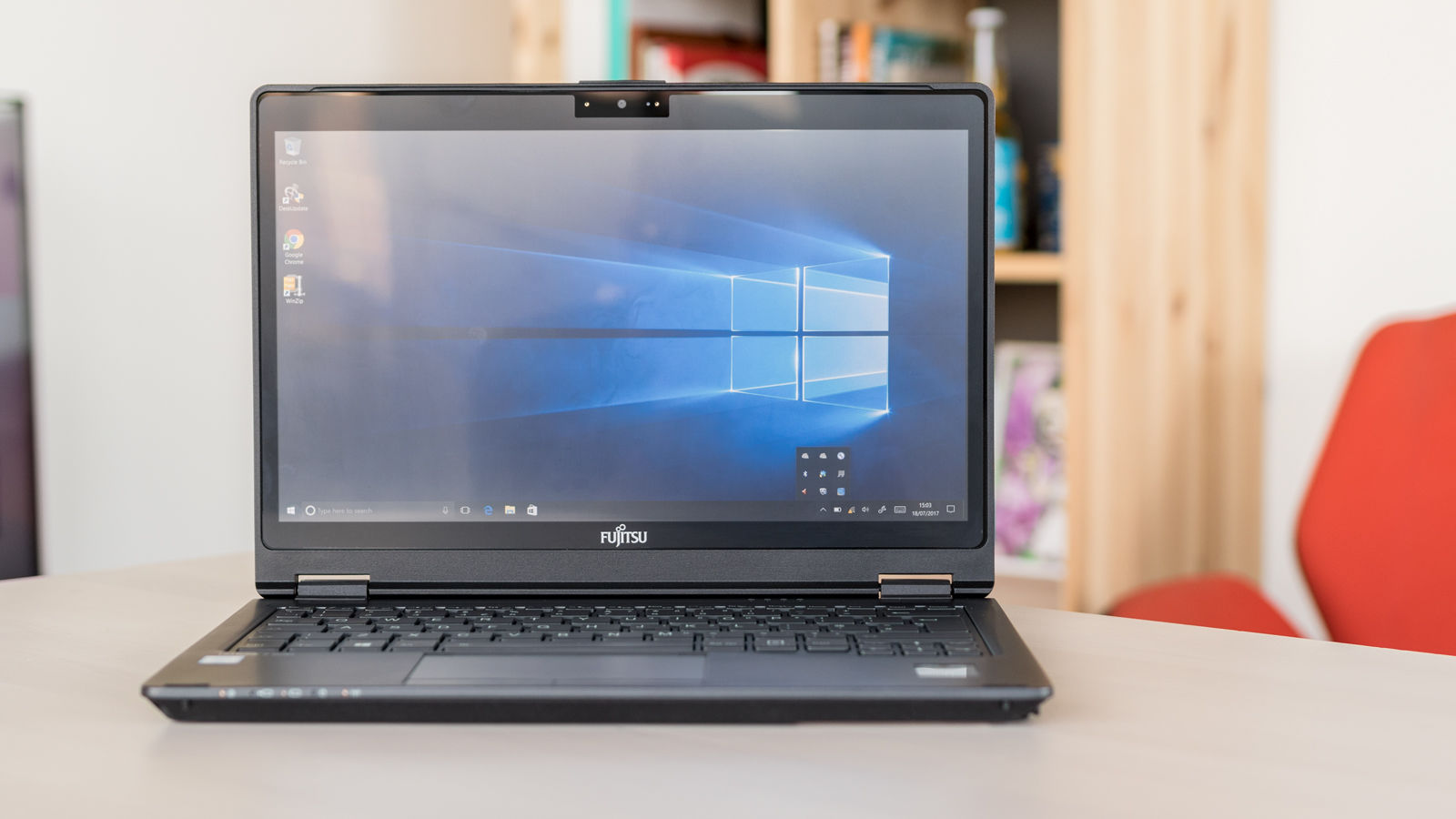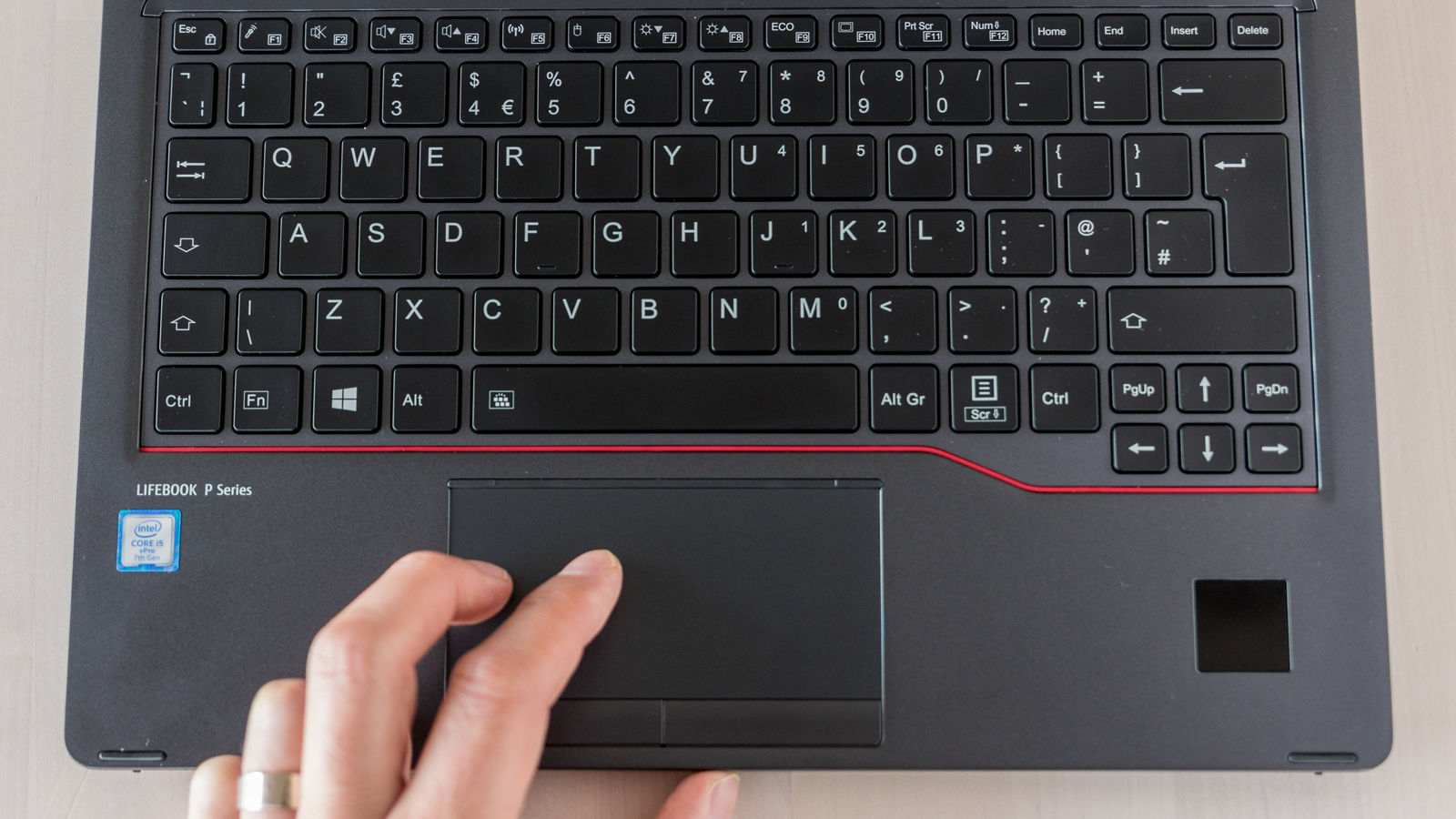You won’t want to take it on holiday or give it to the kids to keep them busy, but it’s not meant for those things (and if your company gives you one, they won’t want you to do that anyway). Far afield from the commercial excitement of iPads sits the humble business laptop, and it’s good to see a company other than Dell produce a stellar offering. The Lifebook P series model I reviewed here is the P727, a 360 degree foldable 2-in-1 laptop. You’re unlikely to want (or be able) to pick it up for casual personal use, but if you’re a small business owner looking to equip yourself or your workforce with an adaptable lightweight computer, this could well be it. Even buyers for larger enterprises would do well to take notice of Fujitsu; the P727 is an example of the excellently flexible hardware on offer to companies who want employees to actually enjoy using their work machines.
Price and availability
The Fujitsu Lifebook P727 is available in the UK on eBuyer at the time of writing for £1,379.99. This price is for the Core i5-7200U model, a step down from the i5-7300U unit I tested. This is quite pricy for a single unit, and if you’re buying for many workers or even a purchaser of technology for enterprise, it’d be worth contacting Fujitsu directly to discuss bulk buying.
Design and build
The relative uniformity of the P727’s design is actually its secret weapon. Despite housing an impressive array of ports, the laptop is far from bulky. It’s not as thin as a MacBook Air, but you won’t mind carrying it from room to room, meeting to meeting or all day in a bag. The sombre black matte finish is the right one for what is a corporate product and when shut it is a compact, A4 sized device. Open, it can act as a standard laptop with its full size 85-key keyboard but can also rotate a full 360 degrees and act in tablet form. This is aimed at business users who might want to present with the machine in their hands, or even for kicking back with a film on the commute. It packs in two USB-A ports, one USB-C for data and power delivery, Ethernet port, SD card slot, headphone jack, HDMI port, VGA port, Smartcard reader and a Kensington lock port. You’ll never be stuck for ports in a meeting for that important presentation. It’s all built around the 12.5in touchscreen. The versatility afforded by touchscreen on Windows 10 helps improve workflow, but you don’t have to use it. It’s handy though, and you’ll find yourself using it. Fujitsu had thoughtfully pre-installed a decent anti-glare screen protector that doesn’t hamper your view or the screen’s brightness, and means you wont smother the display with greasy prints. If you got handed the P727 by the IT department at your company, I’d wager you wouldn’t be too disappointed. It’s a device that isn’t exciting but will draw you in and encourage you to get work done thanks to its portability, versatility and simple design.
Hardware, features and specifications
The laptop measures 299 x 209 x 18.79mm and weighs a reasonable 1.2kg. This means it’s very easy to carry all day in a bag or even in your hands. It all houses a compact, lightweight powerhouse.
Processor, RAM and graphics
My review unit ran an Intel Core i5-7300U 2.6GHz processor that can clock up to 3.5GHz. You can configure at purchase to a slightly lower powered i5, and also i3 or i7. I also had 8GB DDR4 RAM that was sufficient for my usage, with options of 4GB or 16GB for different use cases. It’s unlikely that many business applications will need 16GB RAM but for all-day multitasking with multiple browser windows, email and enterprise software your company may install, it could be necessary. This is supported with a decent Intel HD Graphics 620. This is more than enough combined power to see a business user through any taxing task.
Benchmarks
Here I benchmarked the Lifebook P727 against other Core i5 machines in the similar Dell Latitude 13 7000 and also the Huawei Matebook E 2-in-1. The Lifebook had the best PC Mark 8 score of all, and even beat a Core i7 Dell at the same test.
in GFXBench T-Rex and Manhattan tests, the Core i5 Lifebook even equalled or outperformed the latest Microsoft Surface Pro. Impressive stuff, but it should be expected when you consider Fujitsu’s target market and the price of the P727. Real world use was also very smooth, and I came across no major stumbling block in two weeks of use with the machine.
Display
The 12.5in touchscreen has a surprisingly unobtrusive anti-glare screen protector installed on it that stops finger print and sun glare while still allowing a decent representation of the full HD screen underneath to shine through. Though to fully appreciate it, you will have to remove the protector. Under there is a Full HD display with a resolution of 1920 x 1080. Cheaper models have a resolution of 1366 x 768. Viewing angles are very good, and colour representation is fairly accurate though this isn’t the most vibrant screen. Colours can sometimes appear washed out, though that is down to the anti glare protector that I opted not to remove. Some might find the 12.5in size too small for a primary device, but the P727 isn’t meant to be one. You’re likely to use it as your road tool and in meetings to hook up to external displays. With VGA, HDMI and USB that will not be a problem. Rotated to 360 degrees, the computer can be used as a tablet, and at this position the keys will not register when pressed. You will thank the screen protector in this situation and the display is nicely responsive, but it’s an awkward thing to use for very long as it’s pretty heavy in one hand.
Trackpad and keyboard
The flat keys have a traditional travel of 1.7mm and is comfortable, though for my tastes they were ever so slightly too far apart. Once I built up a rhythm it was pretty easy to get a decent words per minute count going, but I’d say that comparable Dell Latitude laptops are more comfortable long session writing machines.
Security
There’s also palm recognition technology, a biometric security feature that is more secure than fingerprint readers. The contactless sensor on the bottom right of the device allows you to hover your hand over it while it reads the veins in your palm (yes, really) that are far harder to mimic than a fingerprint. Morosely, Fujitsu made a point of letting me know that a severed hand won’t work, as the system also must detect a pulse. So that’s OK then. Thankfully despite a slightly tricky set up, the login option works pretty well. You can enrol both hands and be sure that if you log out, no prying eyes (or palms) will be able to get into your computer. This is something every consumer desires for personal data security but is also great for guarding business and enterprise documents and data. You can also set up a fingerprint if you’d prefer, but the additional security afforded by the flagship palm feature injects a little excitement into an undeniably plain product.
Battery life
Of course, if you need a laptop to be on the road or away from the office (and a plug) then you need decent battery life. Thankfully the P727 has it, with Fujitsu promising 10 hours, but with a killer feature of 80% charging in just under an hour. This claim is no lie, and I found the unit charging brilliantly quickly from near empty. It’s a great feature. However the 10 hours promised fell short in real world use, and when starting work at 9.30am using the laptop as my main device, I was often reaching for the charger by around 3pm. IN our battery test too with a two-hour film file at 720p on a loop with the screen set at 50% brightness, the supposed 10-hour battery conked out after 5 hours and 10 minutes. This isn’t great by any means, and goes some way to explaining the inclusion of particularly fast charging tech.
Software
The P727 comes with Windows 10 Pro preinstalled, and it’s an excellent software suite for the laptop’s target audience. Incorporating compatibility with Workplace Protect, the software for palm vein recognition, alongside Windows 10 is unobtrusive and means workers familiar with Windows can crack on without obstructive enterprise software. Of course some employers will have to install such updates but the clean version of this operating system that I tested is built around productivity. Office’s Word, Excel, PowerPoint and Outlook give most businesses the software foundations to build up from and they’re all here along with OneNote, Access and Publisher. With the Windows Store constantly improving, you will be able to load up the P727 with personal-use apps no problem, even if you or your employer does also need to clog it up with necessary work platforms. Tablet mode in Windows 10 remains annoying to me; flipped to 360 degrees the P727 is meant to be used as a tablet but the limitations and unfamiliar gestures and buttons tablet mode needs you to learn become annoying. The only alternative is touchscreen input in Windows 10’s standard mode but you’ll still want the keyboard for most things. The best thing about the touchscreen is using it for occasional touch input – you won’t want to use this computer as a tablet, but you’ll find the option and some of the uses improve your desk-based workflow for moving windows, pressing OK and opening notifications. Henry is Tech Advisor’s Phones Editor, ensuring he and the team covers and reviews every smartphone worth knowing about for readers and viewers all over the world. He spends a lot of time moving between different handsets and shouting at WhatsApp to support multiple devices at once.




